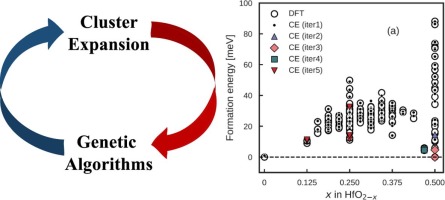当前位置:
X-MOL 学术
›
Comp. Mater. Sci.
›
论文详情
Our official English website, www.x-mol.net, welcomes your
feedback! (Note: you will need to create a separate account there.)
pyGACE: Combining the genetic algorithm and cluster expansion methods to predict the ground-state structure of systems containing point defects
Computational Materials Science ( IF 3.1 ) Pub Date : 2020-03-01 , DOI: 10.1016/j.commatsci.2019.109482 YingXing Cheng , Linggang Zhu , Jian Zhou , Zhimei Sun
Computational Materials Science ( IF 3.1 ) Pub Date : 2020-03-01 , DOI: 10.1016/j.commatsci.2019.109482 YingXing Cheng , Linggang Zhu , Jian Zhou , Zhimei Sun

|
Abstract Searching the most stable atomic-structure of a solid with point defects (including the extrinsic alloying/doping elements), is one of the central issues in materials science. Both adequate sampling of the configuration space and the accurate energy evaluation at relatively low cost are demanding for the structure prediction. In this work, we have employed a framework combining genetic algorithm, cluster expansion (CE) method and first-principles calculations, which can effectively locate the ground-state or meta-stable states of the relatively large/complex systems. We employ this framework to search the stable structures of two distinct systems, i.e., oxygen-vacancy-containing HfO2−x and the Nb-doped SrTi1−xNbxO3, and more stable structures are found compared with the structures available in the literature. The present framework can be applied to the ground-state search of extensive alloyed/doped materials, which is particularly significant for the design of advanced engineering alloys and semiconductors.
中文翻译:

pyGACE:结合遗传算法和聚类扩展方法预测含点缺陷系统的基态结构
摘要 寻找具有点缺陷(包括外在合金/掺杂元素)的固体的最稳定原子结构是材料科学的核心问题之一。配置空间的充分采样和相对较低成本的准确能量评估都要求结构预测。在这项工作中,我们采用了结合遗传算法、聚类扩展(CE)方法和第一性原理计算的框架,可以有效地定位相对大/复杂系统的基态或亚稳态。我们使用这个框架来搜索两个不同系统的稳定结构,即含氧空位的 HfO2-x 和 Nb 掺杂的 SrTi1-xNbxO3,与文献中可用的结构相比,发现了更稳定的结构。
更新日期:2020-03-01
中文翻译:

pyGACE:结合遗传算法和聚类扩展方法预测含点缺陷系统的基态结构
摘要 寻找具有点缺陷(包括外在合金/掺杂元素)的固体的最稳定原子结构是材料科学的核心问题之一。配置空间的充分采样和相对较低成本的准确能量评估都要求结构预测。在这项工作中,我们采用了结合遗传算法、聚类扩展(CE)方法和第一性原理计算的框架,可以有效地定位相对大/复杂系统的基态或亚稳态。我们使用这个框架来搜索两个不同系统的稳定结构,即含氧空位的 HfO2-x 和 Nb 掺杂的 SrTi1-xNbxO3,与文献中可用的结构相比,发现了更稳定的结构。











































 京公网安备 11010802027423号
京公网安备 11010802027423号